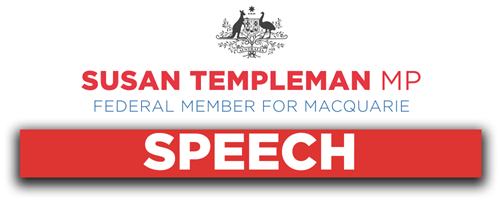
I would urge the member for Lindsay, if she's looking at delays and other things, to look at the New South Wales Liberals and ask them what's happening. Let's remember that so much of our funding goes to that state government, and, gee, I'm hoping that on Saturday we get a new state government in New South Wales, a Labor state government who'll be able to deliver on the things that people expect. In Greater Western Sydney our infrastructure has been long neglected by state and federal Liberals, but under the Albanese government there's real money to get these key projects going. The new Richmond Bridge, with $400 million for the duplication of the bridge, follows the process we started in 2010. It's crucial that this project is done right so that the benefits are real, while reducing the negative impacts. I'll continue to support the community as the New South Wales government work through the design.
The October budget contained an additional $11.2 million to upgrade local roads in the Hawkesbury and $12.5 million for Blue Mountains roads. This nearly $25 million package will be delivered through councils, and I look forward to working closely with them as they now proceed to do the roadworks. Plus, there was $300 million for the Western Sydney roads package, which has $50 million for planning and proprietary works for the Castlereagh Connection to Castlereagh Road, $37 million for Richmond Road planning and $75 million for planning and early works in the north-west growth corridor, all of which have been long needed so that they bring improvements in connectivity and reduce congestion.
There's a myriad of smaller projects through programs such as Roads to Recovery and black spots funding, but we're also moving on those longer-term, big projects, with making high-speed rail a priority. We've already passed the legislation to establish the High Speed Rail Authority, and the speed rail connections between Sydney, the Central Coast and Newcastle are moving closer to reality via a $500 million investment to start corridor acquisition, planning and early works, all the stuff that has to happen to make these things land on the ground.
The former government made promises without ever thinking about how to deliver them, often without talking to even the state or territory governments they'd later rely on and partner with. For years they pretended money was in the budget for zombie project—ridiculous. The Albanese government is ensuring the Commonwealth's infrastructure spending is responsible, affordable and sustainable, while making up for nearly a decade of waste and missed opportunities.
The biggest piece of infrastructure impacting the Blue Mountains, in my electorate, is the Western Sydney airport. I hold very strong views about this airport, and my biggest concern is the effect of flight paths on the residents of the Blue Mountains region and the World Heritage area. It's an area where the ambient noise levels are low, and even the current Sydney Airport flight paths can cause annoyance. By the middle of the year we will see the planned flight paths, and I want to acknowledge the minister for infrastructure for being open about the planning process and recognising the strength of feeling on this, including from my constituents. There are a few things we do already know. We know that the Blaxland merge point is gone and any other single merge point is gone. We know that overflights of residential areas and noise-sensitive facilities will be avoided to the maximum extent possible. We know that airspace design will consider the impacts of air operations on natural and visually sensitive areas, and we know there is a requirement to minimise the impact of night-time aircraft operations.
But we also know that this is a 24/7 airport and that the Blue Mountains will be subjected to additional aircraft noise. So, what can people expect? Well, when the preliminary flight path design is released, it will have a noise tool that will allow you to put in an address and see what the likely impact will be. I want people to really understand what lines on paper mean for us in real life, and this noise tool is vital for that. I expect wide discussion and, to be frank, concern when that is released. After that, there'll be the formal EIS process, specifically for the flight paths, which will contain additional detailed studies and information and to which people will have a chance to put in a formal submission.
The government's commitment is that the time available to respond will be well beyond the statutory requirement. I'll be ensuring that information is widely shared as this progresses, but I'd urge people to be familiar with the new website that's been launched, wsiflightpaths.gov.au. That was released at the FoWSA meeting I attended on Saturday, and I want to than
n

